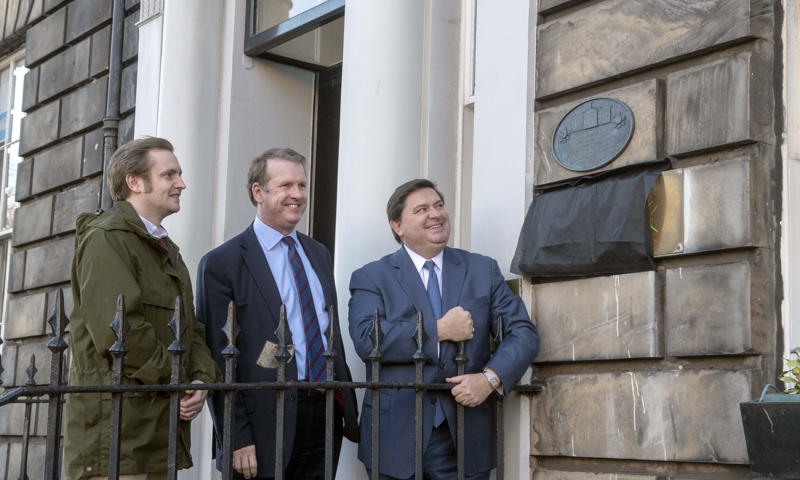A group of Scots stonemasons who were instrumental in the construction of the White House have been honoured in their home city of Edinburgh today (Friday 26 October).
Alex Paterson, Chief Executive of Historic Environment Scotland (HES) was joined by Stewart McLaurin, President of The White House Historical Association to unveil the plaque at 66 Queen Street in Edinburgh. The building was one worked on by stonemasons John and James Williamson, before they travelled to Washington D.C. to commence work on the US Presidential residence.

The Williamson brothers were among a group of six members of Edinburgh Lodge number 8 who travelled to the USA in 1794, and whose skilled craftsmanship would make its mark on the White House.
The stonemasons carried out elaborate carvings on the façade of the structure, including the iconic ‘Double Scottish Rose’ which features on many different parts of the building.
Recently Charles Jones, Technical Conservation Skills Programme Manager and time served stonemason at HES, followed in the footsteps of the Williamson brothers when he was commissioned to carve a replica Double Scottish Rose by the White House Historical Association during a Symposium earlier this year. The replica is now on display in the White House Visitors Centre.
Alex Paterson, Chief Executive of HES, said: “Skilled Scottish stonemasonry was highly sought-after during the 18th century, and the important work undertaken on the White House demonstrates its lasting global significance.
"At HES, as well as highlighting the historic importance of Scottish stonemasonry, we are committed to keeping traditional skills alive. We are helping to sustain stonemasonry and other traditional craft skills in a range of ways: from our training and apprenticeship programmes, including our partnership with Forth Valley College and our dedicated Conservation Centre in Elgin, to the research and cutting-edge technology at the Engine Shed, Scotland’s first building conservation centre.
“This plaque is a fitting tribute to the pioneering Scottish stonemasons of over two centuries ago, and I hope it will provide inspiration for our next generation of craftspeople to carve their names in history."
Stewart McLaurin, President of the White House Historical Association, said: “The stone masons of Scotland today are the legacy of great craftsmen from the 18th century who came to Washington and created the beautiful carvings that we still see on the White House.
"The Double Scottish Rose that we see on every pilaster is a Scots wink from those stonemasons and we were thrilled to have a reminder of that extraordinary stonemason talent."
The story of the stonemasons is explored in a new exhibition now on display at the Engine Shed in Stirling. The Scots Who Built the White House, housed at Scotland’s building conservation centre, examines the role played by these Scottish stonemasons in the construction of one of most iconic buildings in the world, and how their legacy survives in modern Scottish stonemasonry. Exhibits on display include the 18th century masons mark book containing mason marks of both John and James Williamson, and the meeting minutes book where the trip was discussed, both on loan from Edinburgh Lodge 8. A replica of the Double Scottish Rose, carved by HES stonemasons, will also be on display.
The Scots Who Built the White House is now on display at the Engine Shed in Stirling until Friday 12 April 2019. Entry is free.
About The White House Historical Association
First Lady Jacqueline Kennedy envisioned a restored White House that conveyed a sense of history through its decorative and fine arts. In 1961, the White House Historical Association was established to support her vision to preserve and share the Executive Mansion’s legacy for generations to come. Supported entirely by private resources, the Association’s mission is to assist in the preservation of the state and public rooms, fund acquisitions for the White House permanent collection, and educate the public on the history of the White House. Since its founding, the White House Historical Association has contributed more than $47 million in fulfilment of its mission.
About Historic Environment Scotland (HES)
- We are the lead public body charged with caring for, protecting and promoting the historic environment. We will lead on delivering Scotland’s first strategy for the historic environment, Our Place in Time.
- Historic Scotland is a sub brand of HES.
- View our press pack and keep up to date by registering for media release email alerts. If you wish to unsubscribe, please contact us.
Year of Young People 2018
The Year of Young People (YoYP 2018) will inspire Scotland through its young people aged 8 to 26, celebrating their achievements, valuing their contributions to communities and creating new opportunities for them to shine locally, nationally and globally.
Over 200 young people throughout Scotland will become #YOYP2018 Ambassadors, ensuring their communities know about local opportunities to celebrate young people.
Follow Historic Environment Scotland
Twitter: @HistEnvScot | @welovehistory
Facebook: @HistoricEnvScotland | @VisitHistoricScotland
For further information, please contact:Claire Mullaney
Historic Environment Scotland Media Office
Direct Line: 0131 668 8588
Mobile: 07881 512 379
communications@hes.scot


